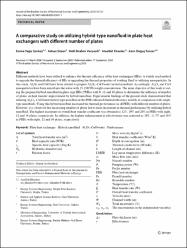A comparative study on utilizing hybrid-type nanofluid in plate heat exchangers with different number of plates

Göster/
Tarih
2020Yazar
Gürbüz, Emine YağızSozen, Adnan
Variyenli, Halil Ibrahim
Khanlari, Ataollah
Tuncer, Azim Dogus
Üst veri
Tüm öğe kaydını gösterÖzet
Different methods have been utilized to enhance the thermal efficiency of the heat exchangers (HEs). A widely used method to upgrade the thermal efficiency of HEs is upgrading the thermal properties of working fluid by utilizing nanoparticles. In this study, Al(2)O(3)and CuO have been utilized to prepare Al2O3-CuO/water hybrid nanofluid. Accordingly, Al(2)O(3)and CuO nanoparticles have been mixed into the water with 1% (50:50) weight concentration. The main objective of this work is testing the prepared hybrid nanofluid in plate-type HEs (PHEs) with 8, 12 and 16 plates to determine the influence of number of plates on heat transfer improvement by hybrid nanofluid. Experimental findings of the present study demonstrated that utilizing Al2O3-CuO/water hybrid-type nanofluid in the PHE enhanced thermal efficiency notably in comparison with single-type nanofluids. Using this hybrid nanofluid increased the thermal performance in all PHEs with different number of plates. However, it is observed that increasing number of plates led to more increment in thermal performance by utilizing hybrid nanofluid. The highest increment in overall heat transfer coefficient was obtained as 12%, 19% and 20% in PHEs with eight, 12 and 16 plates, respectively. In addition, the highest enhancement in effectiveness was achieved as 10%, 11.7% and 16% in PHEs with eight, 12 and 16 plates, respectively.

















